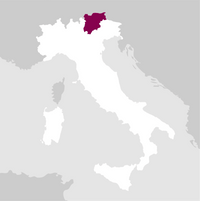Description
The unique white Nosiola grape is native to Trentino and finds its true home on the hillsides of Pressano and the Cembra Valley. In its historic production area on the marlrich soils of Pressano, Nosiola develops a unique aroma and structure.
Details

Perfume

Color

Taste
Serve at:
08 - 10 °C.
Longevity:
03 - 05 years

Pairings
- Start up year: 1948
- Oenologist: Ezio Dallagiacoma, Marco Sartori
- Bottles produced: 2.000.000
- Hectares: 400
The logo takes inspiration from a decorative element that has always been present in the company and bears a highly symbolic value: a wooden bas-relief celebrating the founding of the winery in 1948 which represents the coats of arms of the municipalities of Lavis, Giovo and Meano, the very first protagonists in the association’s establishment. A timeless brand of great strength that puts the Winery and its founding values at the centre: cooperation, history and the bond with the territory.
The Lavis wine-makers cooperative traces its origins to 1850, when the Cembran family built the initial core of the current production unit. It was officially formed in 1948 by 14 independent wine-makers and grew in the years that followed, due partly to acquisitions of other producers, including mergers with the Salorno Cooperative of South Tyrol in 1969 and Cantina Sociale di Cembra in 2003. Read more


| Name | La Vis Nosiola Vigneti delle Dolomiti 2024 |
|---|---|
| Type | White still |
| Denomination | Vigneti delle Dolomiti IGT |
| Vintage | 2024 |
| Size | 0,75 l |
| Alcohol content | 12.0% by volume |
| Grape varieties | 100% Nosiola |
| Country | Italy |
| Region | Trentino Alto Adige |
| Vendor | La Vis |
| Origin | Lavis, Pressano, Sorni and the lower Cembra Valley |
| Climate | Altitude: 400m. a.s.l. Exposure: South, South-West. |
| Soil composition | Partly silty, fertile and moderately deep, and partly porphyritic, loose and fairly shallow. |
| Cultivation system | Simple Trentino pergola. |
| Plants per hectare | 4,500kg/h. |
| Harvest | Manual harvesting in early October. |
| Wine making | Soft pressing in an inert environment, static decantation of the must, fermentation at controlled temperatures in stainless steel tanks. |
| Aging | On the lees for approximately 5/6 months before bottling. |
| Allergens | Contains sulphites |




